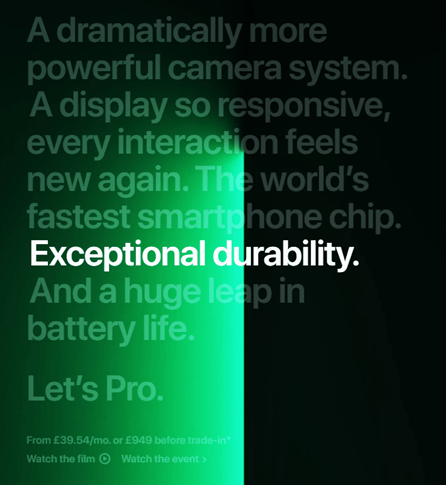WIRED WORDSMITH
TECH
CONTENT
6 Ways To Improve Your Website Marketing Using Content

Use your website to maximum effect to make sales and get leads
1. Set a SMART goal and a target action and focus on them
Decide on a goal for your website. Sites written and designed with a goal in mind are many times more useful and valuable than those without.
Make sure the goal is SMART:
Specific
Measurable
Achievable
Relevant
Timely
It could be worth checking the achievability with a web or marketing expert, or even better – a web marketing expert.
“I will sell £1000 worth of routers on my website by April” is a good example of a SMART goal.
Target action
Next, convert your SMART goal into a target call to action for the site or group of them. These are actions you ultimately want people to take on your site to contribute to your smart goal. In the case of the above goal, the target action(s) would be onsite sales completed when the customer clicks the buy and checkout buttons. Your target action could also be booking a meeting via an app, downloading a document or app, or ringing your sales line through a phone number link, as well as many more.
When writing and designing your site, you will create a call to action for each of your goal actions – this will usually be a button, link or form. Then you will work backwards, designing your whole site to take users on a journey that ends with that call to action.
Think of your web pages as stepping-stones on this journey and links between them as the strides your prospect takes from one to another.
You can’t make the user move closer to your final goal action. That will scare prospects away. Your goal is to design the site so they’ve always got the option to take a step closer, and to create the content to make them want to take that step.

2. Talk about the customer.
What were you thinking about the last time you bought something?
I’m guessing it was about you, the buyer, not the seller, not how much experience they had, not what the latest news in their office was.
The customer thinks first about themselves, what they want and their problems, not you and your offerings. So if you want to talk to them, instead of at them; and if you want to engage them, instead of bore them, you need to talk about them, their needs and how they will benefit from whatever you are promoting.
One of the most common content errors we see on promotional sites is overuse of ‘we’ and underuse of ‘you’. People are saying we sell health insurance, we have a new offer, we’re a good choice. Instead of you can keep your family safe, secure and healthy, you can save money and you’ll have peace of mind with the best provider.
It should all be about benefits to the customer and the problems your offering can solve for them. We’ll talk about how you align this with your need to sell something in part three. For now, let’s talk Google.

2. b. Write what your customers are searching for on Google.
Google is the most powerful internet marketing tool in existence and your site should take advantage of it. Don’t worry, you don’t have to have a degree in search engine optimisation (SEO) or a massive marketing budget to do this.
All you need to do is to find out what your target customers are searching when they're looking for products and services like yours, and include that in your written content.
What are my customers searching for?
The simplest way to find this out is via. The Wordstream Keywords Tool – There are hundreds of tools like this online, but the Wordstream one is the simplest, and is cost and subscription free. Google Ads is another, more complex option which requires a signup.
Enter a keyword in the main box, pick a country and industry, and it will show you some of the most popular terms associated with that keyword, along with how frequently each is searched for.
How to find your businesses keywords on WordStream (the easy method)
1. Enter your business type and each of your services or products as keywords, one by one, being as specific as possible. If you have lots of offerings, group up similar ones.
2. For each, pick the keywords with high search volume and relatively low competition.
3. Remove all of the terms that aren’t relevant to your business.
4. These are your website keywords.
Use these keywords frequently, especially on the relevant product or service pages. The best places to use them are in headers or the top part of your pages. Don’t overdo it though. Stay relevant, avoid being repetitive and only use keywords if they fit naturally into what you’re saying.
I also advise including your location next to the keywords occasionally, especially in things like service and product page headings – Accountants in Leeds is going to get you many more results than just Accountants.
3. Align what they want with what you need
So now we have your SMART goal, and the target action you need your customers to take to get you there. These are the things you need to happen in order for your website, and presumably your business, to succeed.
The sad fact is that the visitors to your site probably don’t know or care about either of these goals. They just want to be entertained, to be informed or to get something that benefits them. Your job in designing your site and populating it with content is to align this desire with your goal, so you can fulfil both of them with that one target action and transaction. You need to show them how buying from you, or booking a meeting or downloading a guide will be good for them and will solve their problems. This can be simple in some cases, such as niche sales sites, and more difficult in others, as shown in the examples below.
| Website type | What they want | What you need | Aligned pitch |
|---|---|---|---|
| Lightbulb sales | A lightbulb | To sell lightbulbs | Buy a lightbulb |
| Business consultancy | A solution to their business problem. | To book an initial meeting. | Book a meeting with us and learn to solve your business problems. |
| Information-based (inbound) sales site | Information and advice | To sell a product. | If you valued what we had to say, try our product and get even more value. |
There’s one big tip here:
Start the journey close to their wants and bring them toward your goals
Again, this is easy in the case of our lightbulb seller, and much more difficult in the other cases. But it’s always best to start in alignment with what the visitor wants. That means starting to tell them what they want to know, or showing them what they want to buy, the minute they get on the site.
If they’re looking for advice on fitting lightbulbs and you kick off trying to sell your Bulb-o-matic 3000, nobody is going to buy. If you start with a quick and easy guide to fitting a lightbulb, then mention that the job can be made quicker and easier with your Bulb-o-matic, you’re going to get a lot more take-up. This is because you’ve gently and seamlessly aligned what they want with what you need them to do. Your aim is for the visitor to never feel like you’re ignoring their needs.
Once again, the difficulty and length of this process really does vary. If your visitor is an electrician wanting to learn how to wire up a particular kind of light bulb and you are a consultancy company looking to help them improve their business, you may have to solve several of their problems. You may need give them lots of information about your business, introduce them to your electrician consultancy service and then tell them how to sign up. This can take many pages and bits of content, as well as multiple visits, making continued contact through emails, lead magnets, social media and such an important consideration.
That’s why marketers say it takes 7 points of contact on average before a person will decide to buy an advertised product. Of course, this varies massively depending on the business.
It takes (roughly) 7 points of contact on average before a person will buy an advertised product.
All this being the case, you need to ask yourself two questions when designing a well-aligned marketing website.
1. How far is my goal from the customer’s initial desire?
2. How many points of contact / pieces of information do I need to show them to align the two?
The answer to these questions will let you know the size of your website marketing effort and what extras need to be included. Do you need a newsletter to keep them interested or social media to build a longer relationship?
A simple sales site, like our lightbulb shop, could manage with just one or two touchpoints – the sales page and possibly an ad. Meanwhile, some sites could need upwards of 10, which could mean involving newsletters and such.
Ads, Google search results and anything else you’ve already shown the visitor count as touchpoints. So does the final conversion. Also, remember this is a loose rule, but a good guide.
Creativity can open up shortcuts
If you remember to stay in sync, and you’re clever with your content, you can shorten this journey.
Here’s an example from Apple.com where these two things are perfectly in sync (Although the graphic design could use some improvement).

This takes advantage of the following techniques that you can try too:
- Display wants in big bright text with need-to-knows (like prices) in small text
- Use colourful (but direct) language and visuals to entertain while you tell them your need-to-knows
- Mix product and service specifications with benefits e.g. “A display so responsive, every interaction feels new again”
- Be brief, especially on the need-to-knows
These tricks and others like them can help you cut down the customer journey, avoid boredom and increase conversions.
4. Be brief when you’re selling
Now we’ve talked about aligning your message, let’s talk about trimming it.
There should be two things between the customer and your goal.
1. What they want to see (wants)
2. What you need them to see (needs)
Prospects will generally want to see how you can help them and what you can give them, as well as being entertained and informed.
You will generally need them to see product specifics, prices, how to progress and legal technicalities.
This is whats important. Everything else can be put further into your site in about pages, blogs, specification pages and technical specs, where the prospect CAN go, but doesn’t HAVE TO go to complete the sale.
Rule of Three
Use the rule of three when you need to be ultra-brief on things like headings and buttons:
Target three words
"Just Do It"
"Always Coca Cola"
Some of the most impactful marketing messages consist of 3 words. Even outside marketing, hard hitting messages like ‘I love you’ and ‘This is it!’ follow the rule.
Use the rule for headers, slogans, bullet points and sound bites.
You won’t be able to get everything down to three words, but you should always aim to get as close as possible. Under 5 is good, over 10 is a no go.

5. Disrupt and brighten up your text
Use headings, bold text, images and more to emphasize positive messages and tell the story in a visually exciting way.
The worst thing to have on a website is a long tract of black and white text. There are many ways you can (and should) brighten these up:
- Headings
- Images
- Backgrounds
- Colours
- Bulleted lists (like this one)
- Multiple pages
- Links
- Page formatting changes
- Infographics
- Italics, bold and underline.
- Testimonials, reviews and case studies – marketing must-haves.
- Clever widgets like sliders
We’re starting to get into the realm of web design here. This is an art in itself, which I could write reams about and a web designer could write even more. .
The best brief advice I can give here is to use as many of these as can be justified before your website starts to look busy and explore how information is presented on other high-quality marketing websites.

6. Bring people to your site, and bring them back again
Website marketing should never end with your website. In fact, it won’t even start if you don’t have a way to bring customers to your site. Websites aren’t highstreet shops. You can’t start a good one and be sure that people will come to it.
We’ve talked about keywords, and they’re a start, but even a well written search-engine optimised site won’t do that well without something to feed it. The main options are below.
Main site feeder options
These are the best options for feeding prospective buyers to your site, pure and simple.
- Social media – The most popular way. Having a following and good messaging is good, but it’s worth looking at social ads too if you want to expand.
- Google Ads – The most immediately effective way. Send prospects to specific product pages or specially designed landing pages, not your home page. More on this later.
- Off-site SEO – The big player’s way. Off-site SEO is a big numbers game which should only be used if you have a big budget and can pair it with other efforts.
Getting people to your site once is a start, but getting them to stay and return is the key to effective website marketing. Here are some ways to achieve this marketing holy grail.
Important on-site and after-site marketing options
- Blog – Give visitors a reason to visit and stay, and give Google a reason to keep sending them your way. Consistent new content is the first step to getting found. This works particularly well with social media.
- Newsletters and emails – Remember the 7 points rule? If your user doesn’t hit enough points to convert in one go, this is a great way to pull them back in. It also works well for offerings where the time needs to be right to buy, like service contracts.
- Remarketing ads – The most efficient ads there are. Target people who have showed interest in your products, but not pressed the buy button, or added them to a trolley and not checked out.
These tools are just as important as your site feeder options. If you pick right and you followed the previous tips too, you’ll have a site that will convert and sell. You can get support with all the steps outlined above from Wireframe.
Book a meeting to get help with any of these steps, or get the lot done by experts
To put it simply, you can get support with everything covered above from us at Wireframe, or we can take it on for you and achieve some great results. Just book a meeting if you need more help or to discuss our offerings.
Summary
1. Set a SMART goal and a target action and focus on them
2. Talk about the customer.
b. Write what your customers are searching for on Google.
3. Align what they want with what you need
4. Be brief when you’re selling
5. Disrupt and brighten up your text
6. Bring people to your site, and bring them back again different source.
All Rights Reserved - Wired Wordsmiths is copyrighted to Wireframe Partners Limited | Privacy Policy



